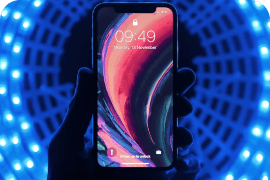eSIM
Do you need to turn on airplane mode when traveling internationally?
You can, but you don't have to.
You might have heard that you should turn on Airplane Mode when traveling internationally to avoid data roaming charges. While it is true that turning on Airplane Mode will help you to avoid international roaming charges, it is a rather extreme method. Let's take a look at what Airplane Mode is all about, and whether or not you really need to turn it on while traveling internationally.

What does airplane mode actually do?
Most, if not all, modern phones today come equipped with an “Airplane Mode” setting. Its primary purpose is to ensure that electronic devices do not interfere with aircraft systems during flight.
When Airplane mode is switched on, your device's ability to connect to cellular networks is disabled. If you had WiFi and Bluetooth turned on, turning on Airplane mode will also switch both WiFi and Bluetooth connections off on your device.
What can I do when airplane mode is turned on?
By turning on airplane mode, you are essentially disabling your device's ability to connect to cellular networks. This means that you wouldn't be able to make calls or send messages via cellular, and you won't be able to connect to the internet using data instead.
However, while airplane mode also turns off your WiFi and Bluetooth by default, it is actually possible to turn these on again on your phone settings. That means that yes, it is actually possible for you to have Airplane mode turned on, but still have WiFi and Bluetooth both turned on.
That is also how you can continue to use the in-flight WiFi in modern aircraft or how you can use your own bluetooth headphones while in flight.
When airplane mode is turned on on your device, all the other features on your device will not be affected and you can continue to use them as per normal as long as you do not require cellular connection. So if you have games that do not require the internet, or if you have media downloaded and ready for offline consumption, you can continue to use those as per normal!
Do I need to turn on Airplane Mode when traveling internationally?
You should turn on Airplane Mode when you are on the flight, so that your device doesn't interfere with the aircraft's communication and navigation systems.
But once you arrive at your destination, you don't actually have to keep Airplane Mode on.
It is true that Airplane Mode can help you to avoid international roaming charges. With Airplane Mode turned on, your device will not be able to connect to cellular service, meaning you will definitely not incur any international roaming charges.
But, if you have airplane mode turned on, it also means that you cannot make any calls or send/receive any messages. You also wouldn't be able to connect to the internet using cellular data.
While airplane mode is definitely a sure way to ensure you don't incur roaming charges, it isn't the only way.
Here are some other ways to help you avoid international roaming charges:
1. Turn off “Data Roaming” on your primary line
One way to avoid international roaming charges will be to go to your device settings, and to disable the Data Roaming option for your primary line.
When the data roaming option is disabled for your primary line, your SIM (or eSIM) will not allow you to use cellular data on a foreign network.
This way, although you wouldn't be able to use your primary line for data connectivity, you will still be able to make calls and send/receive SMSes. However, it is important to note that international calls and messages may also be subject to charges depending on your phone plan.
2. Get a travel eSIM
A travel eSIM will allow you to stay connected and use mobile data without incurring international roaming charges.
Install a travel eSIM for your destination, and update your device settings to use the travel eSIM for your mobile data.
By doing this, you will be using your data plan from your travel eSIM for your mobile data instead of your primary line, which means you wouldn't be incurring international data roaming charges from your primary line.
The good news is that even if you used a travel eSIM for your mobile data, you can still receive calls and messages on your primary line! Similarly, additional charges may be incurred on your phone plan for international calls and messages.
3. Contact your service provider
Another option that you have is to contact your service provider and get them to disable international roaming on your line.
This way, you can be very sure that you will not incur any international roaming charges. However, this could also cause some inconveniences in case of emergency where you need to get connected urgently.
Get a Nomad travel eSIM for your next trip
Nomad offers data plans in over 170 countries, and you can be sure to find one that is suitable for your travel needs. And if you will be traveling across multiple countries, there are also regional plans available so you can stay seamlessly connected as you hop between countries. Data plans are available from as low as $1.50/GB.
The networks that Nomad's eSIMs use for each plan are stated on the plan details on the web store and apps, so you can check which networks are supported before buying your plan.
And, if you are unsure about how much data you need for your trip, Nomad also has a Data Calculator that can help you find the plan that is most suitable for you. Also check out our blog post on data-saving tips when traveling to keep your data usage in check when traveling.
Nomad also has a 24-hour customer support team. So, in the event where you face difficulties while using your eSIM, rest assured there will be someone available to help you resolve your issues!



